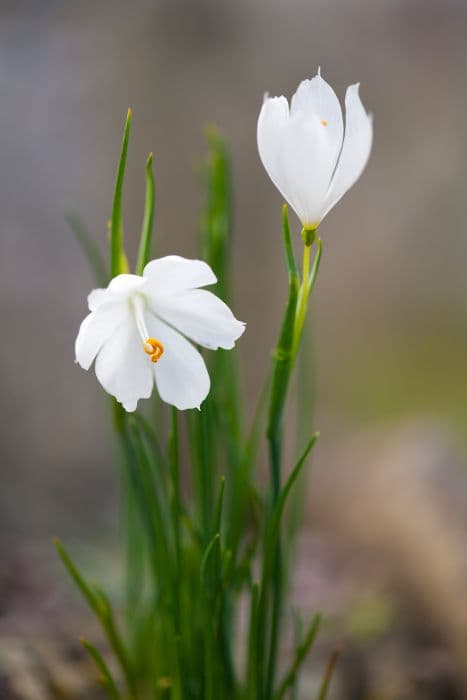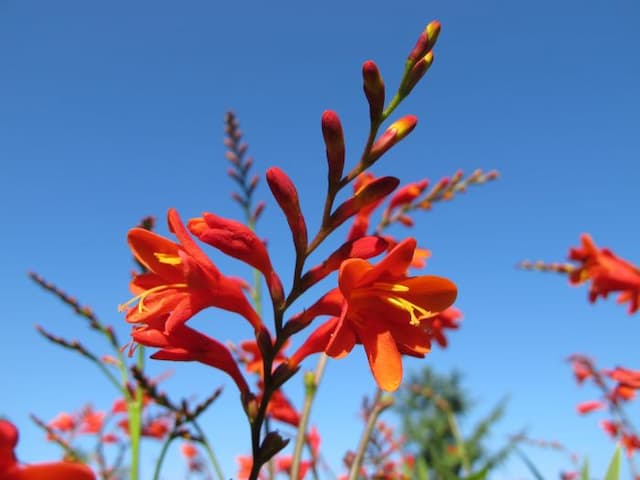Douglas' Olsynium Olsynium douglasii 'Album'

ABOUT
Olsynium douglasii 'Album', commonly known as the white flowering grass widow, is notable for its attractive and delicate flowers. It possesses a clumping form, comprising linear, grass-like leaves that are a deep green in color. The foliage creates a dense tuft from which emerge slender, upright stems that bear the blossoms. The name 'Album' hints at the distinctive coloration of the flowers, which is a pure, bright white. These blooms are star-shaped and consist of six rounded petals that surround prominent yellow centers, giving them a striking contrast against the foliage. The flowers are usually arranged in small clusters at the stem's apex, making them appear as if they're sitting atop the grassy leaves. As a perennial, this plant has a lifecycle that extends over more than one season, continuously adding a soft texture and an alluring floral display to gardens when in bloom. It offers a sense of elegance and simplicity, which makes it a favored choice for rock gardens, borders, and as an accent in naturalized areas. Moreover, the white flowering grass widow can provide a valuable contribution to early spring color in garden spaces.
About this plant
 Names
NamesFamily
Iridaceae
Synonyms
White-Eyed Grass, Douglas' Olsynium, Satin Flower, Douglas' Grass Widow
Common names
Olsynium douglasii var. album, Sisyrinchium douglasii var. album.
 Toxicity
ToxicityTo humans
The plant known as Grass Widow is not generally listed as toxic to humans. However, as with any plant not intended for consumption, individuals may have varying sensitivities, and it is still wise to avoid ingesting plants that are not known to be edible. If a person does consume parts of the Grass Widow and experiences adverse effects, it is recommended to consult a medical professional.
To pets
The Grass Widow is not commonly known to be toxic to pets. That said, it is generally a good practice to prevent pets from ingesting plants that are not meant for consumption, as they might cause gastrointestinal upset or other mild reactions in some animals. If an animal has consumed this plant and shows signs of distress or illness, a veterinarian should be consulted.
 Characteristics
CharacteristicsLife cycle
Perennials
Foliage type
Evergreen
Color of leaves
Green
Flower color
White
Height
1-2 feet (30-60 cm)
Spread
6-12 inches (15-30 cm)
Plant type
Herb
Hardiness zones
4
Native area
North America
Benefits
 General Benefits
General Benefits- Ornamental Value: Adds aesthetic appeal to gardens with its delicate white flowers and grass-like foliage.
- Habitat Support: Offers nectar and pollen for pollinators such as bees and butterflies.
- Low Maintenance: Requires minimal upkeep once established, making it a good choice for low-maintenance landscapes.
- Drought Tolerance: Once established, it can tolerate dry conditions, reducing the need for frequent watering.
- Seasonal Interest: Provides early spring blooms which can add interest to the garden during a time when few other plants are in flower.
- Erosion Control: Its root system can help stabilize soil and prevent erosion on slopes and in garden beds.
- Naturalizing: Can spread over time to form a naturalistic drift of color in the landscape.
- Wildlife Friendly: Can be part of a wildlife-friendly garden design that supports local ecosystems.
- Versatility: Suitable for a variety of garden designs, from rock gardens to borders and container plantings.
- Easy Propagation: Can be easily propagated by division, allowing gardeners to expand their plantings or share with others.
 Medical Properties
Medical PropertiesThis plant is not used for medical purposes.
 Air-purifying Qualities
Air-purifying QualitiesThis plant is not specifically known for air purifying qualities.
 Other Uses
Other Uses- Oregon Sunshine can be used as a photographic subject for macro and nature photography due to its delicate white flowers which provide a compelling contrast against darker backgrounds.
- The plant can serve as a dye source, where the flowers and foliage can be used to create natural dyes for textiles or craft projects.
- In educational settings, it can be utilized to teach botany and plant biology, demonstrating the lifecycle of a perennial plant and its role in native ecosystems.
- It is suitable for creating dried flower arrangements, as the blooms can retain their shape and color when dried properly.
- Artists may use the intricate details of Oregon Sunshine as inspiration for botanical illustrations or nature-influenced art pieces.
- As a thematic element, it can be incorporated into event decor for weddings and garden parties, especially for those with a white or nature theme.
- This plant can be deployed in sensory gardens, where its textures can be experienced up close by individuals with visual impairments.
- It can act as a natural pest deterrent when strategically placed in a garden since some insects avoid certain native plants.
- In landscape design, Oregon Sunshine can be used to create a 'white garden' or monochromatic planting scheme based on flower color.
- Gardeners might use the plant as an indicator species, as its health and bloom can signal soil and microclimate conditions within the garden.
Interesting Facts
 Feng Shui
Feng ShuiThe plant Satin Flower is not used in Feng Shui practice.
 Zodiac Sign Compitability
Zodiac Sign CompitabilityThe Satin Flower is not used in astrology practice.
 Plant Symbolism
Plant Symbolism- Purity: The 'Album' variety of the plant has white blossoms, often associated with cleanliness, innocence, and perfection, which translates into the symbolic meaning of purity.
- Delicacy: Olsynium douglasii 'Album', also known as the White-eyed grass or Satin flower, has a delicate appearance, which suggests a sense of fragility and the precious nature of life.
- New Beginnings: Blooming early in the spring, the Satin flower often symbolizes new starts and the awakening of nature after the winter.
- Adaptation: As a plant that thrives in variable conditions from full sun to partial shade, the Satin flower symbolizes versatility and the ability to thrive in different circumstances.
 Water
WaterFor the Satin Flower, moderate watering is necessary, especially during its active growth in spring. Water the plant deeply once a week, providing enough water to soak the soil thoroughly, which can be around 1-2 gallons depending on the size of the plant and pot. During the dormant period in winter, reduce watering to every other week, as the plant requires less moisture. Ensure proper drainage to prevent waterlogging, as Satin Flower does not tolerate standing water which can lead to root rot.
 Light
LightSatin Flowers thrive best in full sun to partial shade conditions. Place the plant in a spot where it receives at least 6 to 8 hours of direct sunlight daily. If planted outdoors, an east-facing or west-facing location that offers sun with some afternoon shade would be ideal to protect it from the intense heat of the late day.
 Temperature
TemperatureSatin Flower prefers moderate temperatures and can survive in a range between 20°F to 80°F. The ideal temperature for this plant is between 55°F and 75°F. It is cold-hardy and can tolerate light frosts, but prolonged exposure to temperatures below 20°F can be harmful to the plant.
 Pruning
PruningPruning Satin Flowers is mainly done for aesthetic reasons and to remove dead or damaged foliage. Lightly prune the plant after it has finished blooming, usually in late spring or early summer, to keep it tidy and encourage next year's growth. Do not prune heavily, as this can reduce the number of flowers the following season.
 Cleaning
CleaningAs needed
 Soil
SoilFor the Oregon Sunshine, a well-draining soil is crucial to prevent root rot, typically a mixture of loamy or sandy soil with some organic matter is ideal. It prefers a pH range of 6.0 to 7.5. Adding perlite or gravel can improve drainage.
 Repotting
RepottingOregon Sunshine should be repotted every 2 to 3 years to refresh the soil and accommodate root growth. Best done in the springtime, just before the growth season begins.
 Humidity & Misting
Humidity & MistingOregon Sunshine thrives in average room humidity levels. It does well in outdoor humidity too, as long as the soil drainage is good and the plant is not waterlogged.
 Suitable locations
Suitable locationsIndoor
Ensure bright light for Oregon Sunshine and well-draining soil.
Outdoor
Plant Oregon Sunshine in well-drained soil with full sun exposure.
Hardiness zone
4-9 USDA
 Life cycle
Life cycleOlsynium douglasii 'Album', commonly known as the White-flowered Douglas' onion or white Grass Widow, begins its life cycle as a seed which germinates in the spring, once temperature and moisture conditions are suitable. After germination, the plant develops a rosette of narrow, grass-like leaves from which the roots also expand to anchor the plant and absorb nutrients from the soil. As it matures, Olsynium douglasii 'Album' produces flowering stalks with white, star-shaped flowers that bloom typically from late winter to early spring. After pollination, which is often facilitated by insects, the plant sets seed encased in small capsules. Once the seeds mature, they are dispersed, often by wind or water, to colonize new areas where the cycle begins anew. During the summer, the plant goes dormant, with the leaves dying back and the plant surviving as an underground bulb until the next favorable growth season.
 Propogation
PropogationPropogation time
Spring-Early Summer
Propogation: Olsynium douglasii 'Album', commonly known as Douglas' grasswidow, is frequently propagated by seed. The best time to propagate Douglas' grasswidow by seed is in the fall, as the seeds require a cold period to break dormancy. To propagate, the seeds should be sown on the surface of a well-draining seed starting mix and then lightly covered with soil or sand. The pot or tray should be placed in a cold frame or outdoors to allow for the natural stratification process over the winter. With the arrival of spring and warmer temperatures, seeds will germinate as conditions become favorable.








![Montbretia [Little Redhead]](/_next/image?url=https%3A%2F%2Fplants-admin.emdemapps.com%2Fimages%2Fplants%2F%2Fimages%2F604b5635373f8.png&w=640&q=75)
